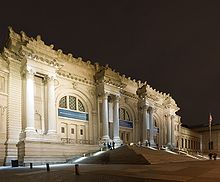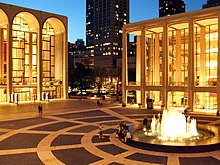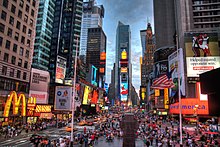| “ | Culture just seems to be in the air, like part of the weather | ” |
—Tom Wolfe | ||
Numerous major American cultural movements began in the city, such as the Harlem Renaissance, which established the African-American literary canon in the United States.
The city was a center of jazz in the 1940s, abstract expressionism in the 1950s and the birthplace of hip hop in the 1970s. The city's punk and hardcore scenes were influential in the 1970s and 1980s, and the city has long had a flourishing scene for Jewish American literature.
Prominent indie rock bands coming out of New York in recent years include The Strokes, Interpol, The Bravery, Scissor Sisters, and They Might Be Giants.
The city prominently excels in its spheres of art, cuisine, dance, music, opera, theater, independent film, fashion, museums, and literature. The city is the birthplace of many cultural movements, including the Harlem Renaissance in literature and visual art; abstract expressionism (also known as the New York School) in painting; and hip hop, punk, salsa, disco, freestyle, and Tin Pan Alley in music. New York City is also widely celebrated in popular lore, featured frequently as the setting for books, movies (see New York in film), and television programs.
Entertainment and performing arts
The city is also prominent in the American film industry. Manhatta (1920), an early avant-garde film, was filmed in the city.
Today, New York City is the second largest center for the film industry in the United States. The city has more than 2,000 arts and cultural organizations and more than 500 art galleries of all sizes.
The city government funds the arts with a larger annual budget than the National Endowment for the Arts. Wealthy industrialists in the 19th century built a network of major cultural institutions, such as the famed Carnegie Hall and Metropolitan Museum of Art, that would become internationally established. The advent of electric lighting led to elaborate theater productions, and in the 1880s New York City theaters on Broadway and along 42nd Street began featuring a new stage form that became known as the Broadway musical.
Strongly influenced by the city's immigrants, productions such as those of Harrigan and Hart, George M. Cohan and others used song in narratives that often reflected themes of hope and ambition. Today these productions are a staple of the New York theater scene.
The city's 39 largest theaters (with more than 500 seats) are collectively known as "Broadway," after the major thoroughfare that crosses the Times Square theater district. This area is sometimes referred to as The Main Stem, The Great White Way or The Realto.
Lincoln Center for the Performing Arts is home to 12 influential arts organizations, including Jazz at Lincoln Center, Metropolitan Opera, New York City Opera, New York Philharmonic. New York City Ballet, the Vivian Beaumont Theatre, the Juilliard School and Alice Tully Hall. It is the largest performing arts center in the United States.
Central Park SummerStage presents performances of free plays and music in Central Park.
Tourism
Tourism is one of New York City's most vital industries, with more than 40 million combined domestic and international tourists visiting each year in the past five years.Major destinations include the Empire State Building; Statue of Liberty; Ellis Island; Broadway theater productions; museums such as the Metropolitan Museum of Art; greenspaces such as Central Park and Washington Square Park; Rockefeller Center; Times Square; luxury shopping along Fifth and Madison Avenues; and events such as the Halloween Parade in Greenwich Village, the Macy's Thanksgiving Day Parade, the St. Patrick's Day parade, seasonal activities such as ice skating in Central Park in the wintertime, the Tribeca Film Festival, and free performances in Central Park at Summerstage. Special experiences outside the key tourist areas of the city include, but are not limited to the Bronx Zoo; Coney Island; and the New York Botanical Garden.
In 2010, New York City had a record number of tourists with 48.7 million. Since the United States economy is still recovering, Mayor Michael Bloomberg's goal is to break the record again in 2012 by drawing more than 50 million tourists.



No comments:
Post a Comment